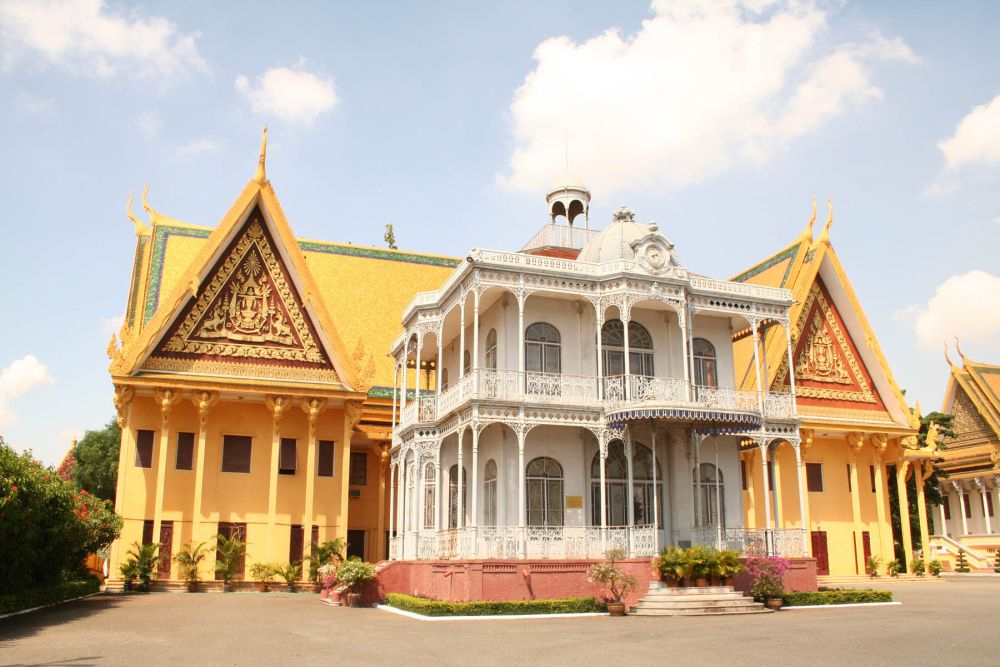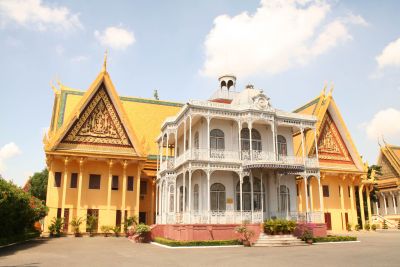

The Silver Pagoda, also known as Wat Preah Keo or the Temple of the Emerald Buddha, is one of the most revered sites in the Royal Palace complex. Named after its floor, which is covered with over 5,000 silver tiles, this pagoda houses many national treasures including gold and jeweled Buddha statues. Among the most notable are a life-sized gold Buddha adorned with 9584 diamonds and a small 17th-century emerald and baccarat crystal Buddha. Apart from religious significance, the architecture and detailed craftsmanship offer a glimpse into the royal heritage. The walls surrounding the pagoda are decorated with murals depicting episodes from the Reamker, the Khmer version of the Ramayana.
The Throne Hall, or Preah Tineang Tevea Vinichhay, is a stunning example of Khmer architecture within the Royal Palace compound and is used for coronations and ceremonial occasions. The hall is noted for its intricate roof and gilded spires, which are a sight to behold against the Phnom Penh skyline. Inside, visitors can admire the lavish interior, including a royal throne and a ceiling fresco depicting the epic Ramayana. It's a place where one can sense the pomp and grandeur of the Cambodian royal ceremonies, and its beautiful gardens make it an excellent spot for photography. Friendly guides are often available to explain the hall's history and significance.
While visiting the Royal Palace, you may have the chance to witness a traditional Cambodian Living Arts performance. These performances include classical dance, folk dance, and traditional Khmer musical demonstrations that have been preserved over centuries. Shows often take place in the beautiful gardens or pavilions of the Royal Palace, allowing audiences to enjoy the local culture in a majestic setting. The performances are not just entertaining but are also part of an important effort to revive and maintain the arts that were nearly lost during Cambodia's turbulent history.
Hor Samran Phirun is often regarded as the personal royal chapel for the King of Cambodia. It's a smaller yet significant structure within the palace grounds, featuring traditional Khmer architectural elements. The chapel stores various royal regalia and visitors can see a set of coronation gear, including the Royal Crown and ceremonial swords. The regalia reflect the opulence of the Cambodian monarchy and their rich historical and cultural heritage. Visitors should remember to speak softly, as this is a place of reverence and an integral piece of the ongoing royal legacy.
The Napoleon III Pavilion is a distinctive structure gifted to King Norodom by the French Empress Eugénie in 1876. Although it contrasts with the traditional Khmer architecture, it adds a unique historical layer to the Royal Palace complex, reflecting the period of French colonial influence in Cambodia. Originally built for the inauguration of the Suez Canal, the iron building was later transported to Cambodia. Today, it serves as a small museum housing various photographs and memorabilia related to the Cambodian monarchy. It's a fascinating spot for those interested in the intersection of European and Khmer historical narratives.
The Royal Palace Gardens are a serene escape from the hustle and bustle of Phnom Penh. Visitors can enjoy a leisurely stroll through manicured lawns, beautiful flowerbeds, and along pathways lined with statues and topiaries. The gardens are immaculately kept and provide a peaceful backdrop to the palace buildings. They also offer an opportunity to see Cambodians practicing traditional exercises and meditation in the mornings. Benches are scattered throughout the area, allowing one to sit and appreciate the tranquility or simply people-watch. Visiting the gardens is a great way to complement your experience of the Royal Palace's grandeur.
The Royal Treasury contains a rich collection of gifts presented to the Cambodian Kings over the years including precious gems, golden statues, and other artifacts of national significance. Located in the same section is the Villa of Napoleon III, a small iron house gifted by the French emperor in the 19th century. Although it's often missed by tourists, it represents an intersection of Khmer culture and French colonial influence in Cambodia's history. Its ornate design and historical artifacts make it well worth the visit for those interested in the finer details of Cambodia's historic ties with France.
The Phochani Pavilion is a spacious hall used for royal receptions and cultural performances. It is an excellent example of Cambodian architectural sophistication with a large, open space that often doubles as an exhibition hall for various art and historical displays. The pavilion is sometimes utilized for traditional dance performances, making it a dynamic venue within the palace grounds. Attendees of these events not only get to appreciate the cultural performances but can also revel in the architectural beauty of the pavilion itself.
To fully appreciate the history and significance of the Royal Palace, a guided tour is highly recommended. Knowledgeable guides offer valuable insights into the symbolism and function of various buildings within the precinct as well as stories about the monarchy and Cambodian history. Tours cover the Throne Hall, Silver Pagoda, Royal Treasury, and other key areas within the complex. Often, guides will share lesser-known facts and anecdotes that enrich the visitor experience, making it a memorable and educational visit to one of Cambodia's most iconic landmarks.
The Changing of the Guard Ceremony at the Royal Palace is an impressive display of pomp and ceremony. Although not as well-known as similar ceremonies in other countries, it offers a glimpse into the royal traditions of Cambodia. The guards, dressed in full regalia, perform their duties with precision and solemnity, reflecting a sense of pride and dedication. This ceremony happens at set times, so it's advisable to check the schedule in advance. Whether you're a military enthusiast or just looking for a unique cultural experience, the Changing of the Guard at the Royal Palace is a sight to behold.
